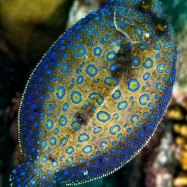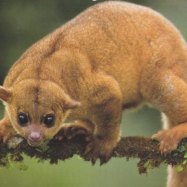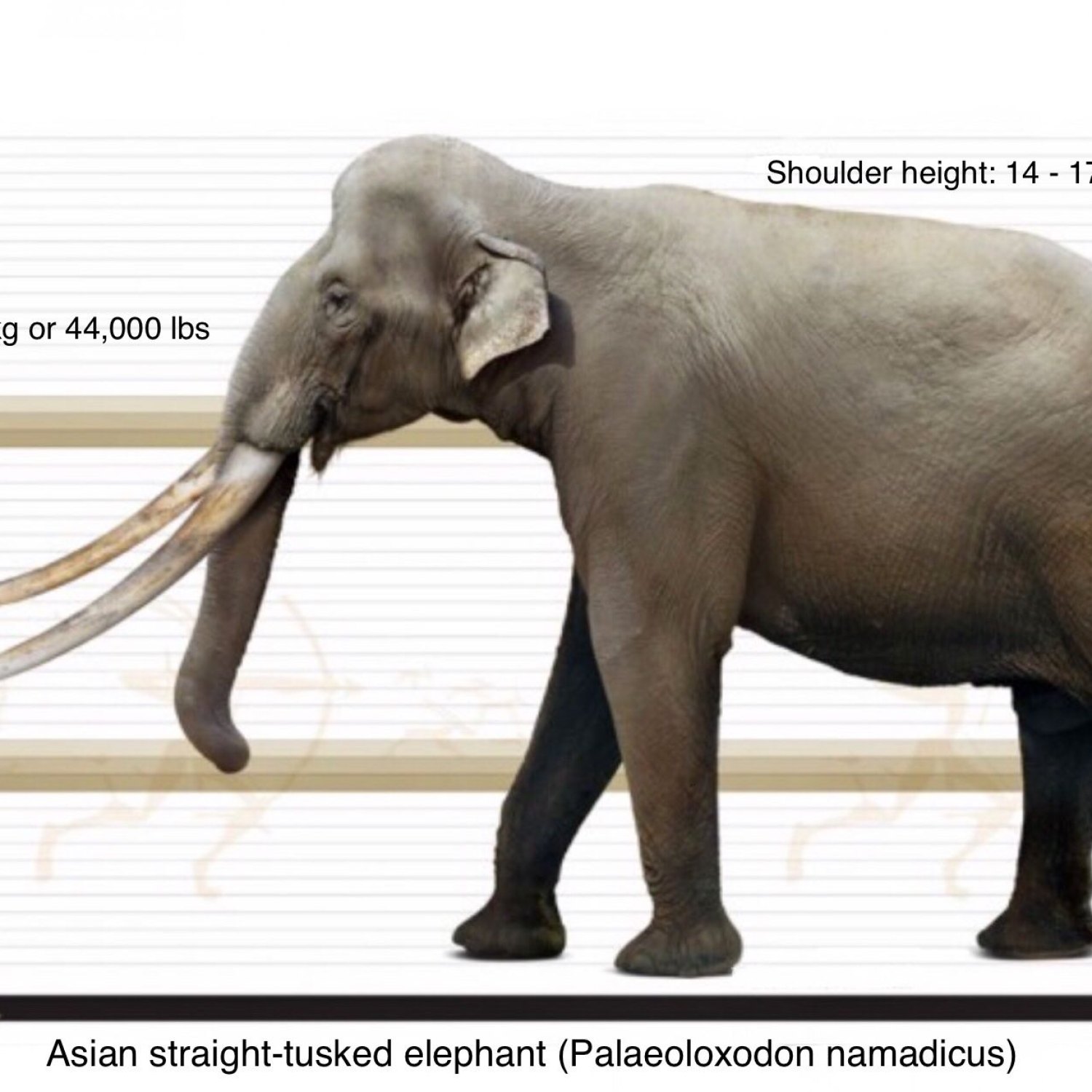
Palaeoloxodon Namadicus
Up to 5 meters
Palaeoloxodon Namadicus, a distant relative of modern elephants, roamed the Indian subcontinent nearly 100,000 years ago. This massive animal, measuring up to 5 meters in length, belonged to the family Elephantidae and had a large and robust body shape. Fossils of this fascinating creature have been found in India, Nepal, and Bangladesh, providing insight into the ancient biodiversity of the region. #PalaeoloxodonNamadicus #ancientelephant #Indianbiodiversity
Animal Details Summary:
Common Name: Asian Straight-Tusked Elephant
Kingdom: Animalia
Habitat: Grasslands, forests, and wetlands
The Giant of Ancient Asia: Palaeoloxodon Namadicus and Its Epic Journey
The majestic elephant is undoubtedly one of the most iconic animals in the world. As the largest land mammal on Earth, these gentle giants have captured our hearts and imaginations with their intelligence, strength, and unique characteristics. From African savannas to Asian jungles, elephants have been an integral part of various cultures and have played a crucial role in shaping ecosystems. However, there is one species that stood out from the rest, not only because of its immense size but also because of its incredible journey through time – the Palaeoloxodon Namadicus, also known as the Asian Straight-Tusked Elephant Palaeoloxodon Namadicus.The Palaeoloxodon Namadicus, with its scientific name derived from the ancient Greek words paleo meaning old, loxos meaning slanted, and odon meaning tooth, was a species of elephant that lived in ancient Asia. It is recognized as one of the largest land mammals ever to roam the Earth, with a height of 4 to 5 meters and a weight of up to 12 tons. These massive creatures were known to have lived in the grasslands, forests, and wetlands of Asia, mainly in India, Nepal, and Bangladesh. Their fossils have been discovered in these areas, often found alongside river banks and lake beds. Despite its massive size, the Palaeoloxodon Namadicus was also an herbivore, feeding on different types of plants and fruits.
The Evolution of Palaeoloxodon Namadicus
The journey of the Palaeoloxodon Namadicus began around 4 million years ago during the early Pleistocene epoch. During this time, Asia was not yet the continent we know today. It was connected to Europe and Africa through land bridges, allowing for migration and exchange of species. The Palaeoloxodon Namadicus is believed to have evolved from the Straight-Tusked Elephant (Palaeoloxodon Antiquus) in Africa, which, in turn, evolved from the Mediterranean species, Elephas Antiquus Pink Toed Tarantula. As the continents drifted apart and sea levels rose, isolation occurred, and the Straight-Tusked Elephants in Asia evolved separately, leading to the emergence of Palaeoloxodon Namadicus.For millions of years, the Palaeoloxodon Namadicus continued to thrive in Asia, dominating the landscape with its massive size and power. These elephants were crucial in shaping the ecosystems of ancient Asia, acting as ecosystem engineers by clearing forests and dispersing seeds, thus creating a diverse habitat for other species. However, their true journey began around 200,000 years ago, during the Middle Pleistocene, when nature put these majestic creatures to the ultimate test.
The Epic Journey: Palaeoloxodon Namadicus During the Middle Pleistocene
The Middle Pleistocene was a critical time for many species, including the Palaeoloxodon Namadicus. It was a period of intense climatic change, with cycles of intense cold and warmth, known as glacial and interglacial periods. These periods had a significant impact on the environment, causing changes in temperature and moisture, leading to shifts in vegetation and food availability.For the Palaeoloxodon Namadicus, these changes meant adapting to a rapidly changing environment. As the climate turned colder, the grasslands and forests that once sustained these massive creatures started to disappear. Food became scarce, and the Palaeoloxodon Namadicus had to travel further in search of food. This journey took them across river valleys and into the Himalayan foothills, where they could find suitable vegetation and water sources. These epic journeys of survival shaped the physical adaptations of the Palaeoloxodon Namadicus, giving them longer legs, making them more agile, and helping them navigate through various terrains.
The Middle Pleistocene also brought a new challenge for the Palaeoloxodon Namadicus in the form of competition from other species. During this time, several large predators, such as Saber-toothed cats and bears, coexisted with the Palaeoloxodon Namadicus. These predators not only posed a threat to the Palaeoloxodon Namadicus but also competed with them for resources. Despite these challenges, the Palaeoloxodon Namadicus managed to survive, proving their resilience and adaptability.
The End of an Era: Extinction of Palaeoloxodon Namadicus
Around 100,000 years ago, as the Pleistocene epoch came to an end, so did the journey of the Palaeoloxodon Namadicus. The Middle Pleistocene marked the peak of their dominance in Asia, but it also signaled the beginning of their decline. The massive changes in the environment, along with competition and hunting by early humans, started to take a toll on these giant creatures. By the end of the Pleistocene epoch, the Palaeoloxodon Namadicus had become extinct, leaving behind only their fossils and their legacy.The exact reasons for their extinction are still debated by scientists. Some believe that their extinction was caused by climate change, with the ever-changing environment becoming too harsh for them to survive. Others argue that hunting and competition with other species played a more significant role in their downfall. Whatever the reason may be, the loss of the Palaeoloxodon Namadicus marked the end of an era in the history of Asian elephants.
Legacy of the Palaeoloxodon Namadicus
Even though the Palaeoloxodon Namadicus is long gone, its legacy continues to live on. Their massive fossils have provided scientists with invaluable information about the ecology and evolution of ancient Asia. These fossils have also helped in creating a clearer picture of the impact of climate change on species and how they adapt to survive.The Palaeoloxodon Namadicus has also left a mark on the culture and lives of people in Asia. In India, the elephant is considered a sacred animal, worshipped in many temples and celebrated in festivals such as the famous Jaipur Elephant Festival. The stories and legends of these gentle giants have been passed down from generation to generation, bringing awareness to the importance of conservation and preservation of nature.
Final Thoughts
The Palaeoloxodon Namadicus may have gone extinct, but its epic journey through time remains a remarkable feat. From evolving into the largest land mammal in the world to surviving intense climatic changes and competing with other species, these incredible creatures have truly left a lasting impact on the world. As we continue to learn more about the Palaeoloxodon Namadicus and its existence, let us remember to honor their legacy by taking care of our natural world and the species that call it home. Who knows, one day, another species may embark on a similar journey, just like the Palaeoloxodon Namadicus, leaving a mark on our planet for generations to come.

Palaeoloxodon Namadicus
Animal Details Palaeoloxodon Namadicus - Scientific Name: Palaeoloxodon namadicus
- Category: Animals P
- Scientific Name: Palaeoloxodon namadicus
- Common Name: Asian Straight-Tusked Elephant
- Kingdom: Animalia
- Phylum: Chordata
- Class: Mammalia
- Order: Proboscidea
- Family: Elephantidae
- Habitat: Grasslands, forests, and wetlands
- Feeding Method: Herbivorous
- Geographical Distribution: Asia
- Country of Origin: India
- Location: India, Nepal, Bangladesh
- Animal Coloration: Gray to brown
- Body Shape: Large and robust
- Length: Up to 5 meters
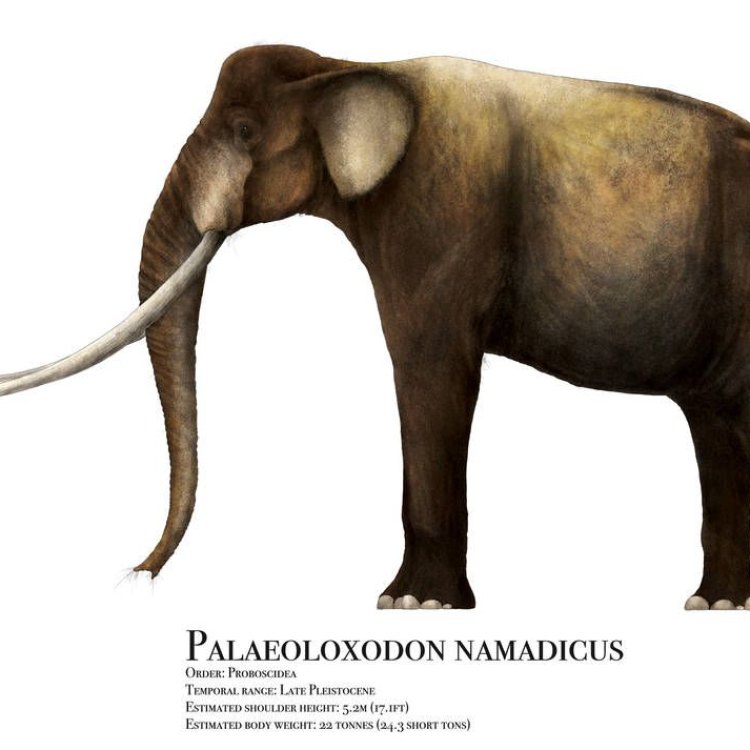
Asian Straight-Tusked Elephant
- Adult Size: Similar to modern elephants
- Average Lifespan: Unknown
- Reproduction: Sexual reproduction
- Reproductive Behavior: Polygynous
- Sound or Call: Unknown
- Migration Pattern: Unknown
- Social Groups: Unknown, but likely to have lived in small family groups
- Behavior: Unknown
- Threats: Hunting by early humans
- Conservation Status: Extinct
- Impact on Ecosystem: Unknown
- Human Use: Unknown
- Distinctive Features: Large, straight tusks
- Interesting Facts: Palaeoloxodon namadicus is one of the largest known land mammals that ever lived.
- Predator: No natural predators
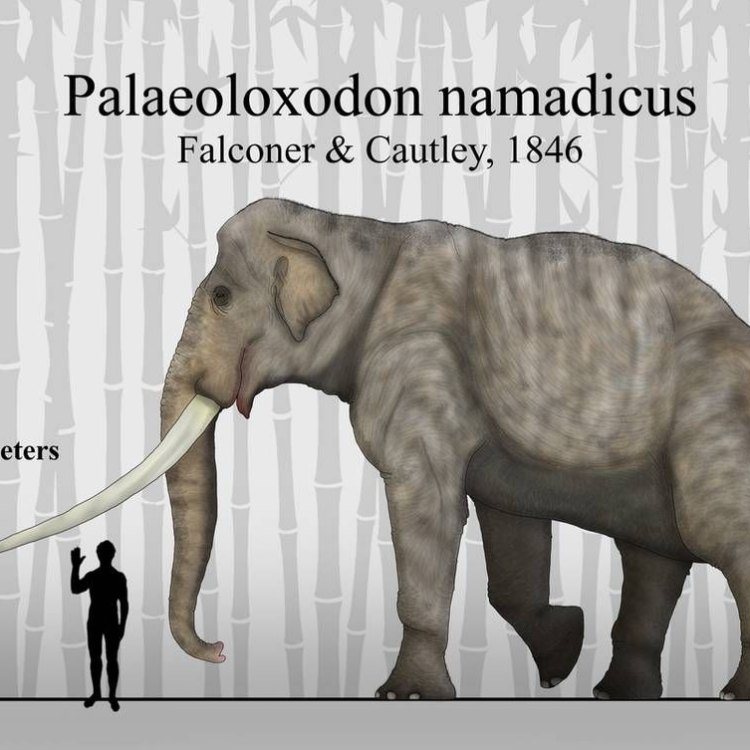
Palaeoloxodon namadicus
The Extinct Giant: Palaeoloxodon Namadicus
The world has witnessed numerous giant and majestic creatures that roam the Earth. From the massive T-Rex to the majestic Blue Whale, these creatures have always captured the imagination of humans. However, there is one forgotten giant that not many people are aware of - the Palaeoloxodon Namadicus.Palaeoloxodon Namadicus is an extinct species of elephant that once roamed the Earth during the Pleistocene and Holocene epochs PeaceOfAnimals.Com. It is believed to be one of the largest known land mammals that ever lived, with an adult size similar to modern elephants. But what makes this species truly fascinating is not just its size, but the unique features and facts surrounding its existence.
Let's delve into the world of Palaeoloxodon Namadicus and discover what made this extinct species a remarkable creature.
Average Lifespan and Reproduction
One of the intriguing aspects of Palaeoloxodon Namadicus is that not much is known about its average lifespan. Since the species is extinct, there is no way to accurately determine the lifespan of these creatures. Scientists could only speculate based on the lifespan of modern elephants, which is around 50 to 70 years.What is known for sure about their reproduction is that they reproduced sexually, like modern elephants. The females would carry their young for around 22 months before giving birth. This long gestation period indicates that the offspring of Palaeoloxodon Namadicus were likely to be precocial, meaning they were born relatively mature and able to follow their mothers shortly after birth Polecat.
Reproductive Behavior and Social Groups
Palaeoloxodon Namadicus' reproductive behavior is believed to be polygynous, meaning males would mate with multiple females. This reproductive behavior is commonly found in modern elephants, where the larger and stronger males would have access to more females.However, not much is known about the social groups of Palaeoloxodon Namadicus. Scientists believe that these creatures lived in small family groups, much like modern elephants. This theory is based on the fact that the offspring would stay with their mothers until they reached maturity, and the females would form close bonds with their relatives.
Sounds and Migration Patterns
Another mystery surrounding Palaeoloxodon Namadicus is their sound or call. Since this species is extinct, there is no way to know what they sounded like. However, based on their close relatives, modern elephants, it is believed that Palaeoloxodon Namadicus would have produced low-frequency sounds that humans cannot hear.The migration patterns of this species are also unknown. As they lived during the Pleistocene and Holocene epochs, the Earth's climate would have been different than it is now. It is possible that they migrated to different places in search of food and water, but there is no concrete evidence to support this theory.
Behavior and Threats
Since Palaeoloxodon Namadicus is an extinct species, scientists can only speculate about their behavior. Based on their physical characteristics, it is believed that they were herbivores, just like modern elephants. They would have likely lived in forested areas, feeding on plants, and using their tusks to access vegetation.Like many other extinct species, the greatest threat to Palaeoloxodon Namadicus was hunting by early humans. With their large, straight tusks, they were an easy target for humans, and their meat and tusks were valuable resources. This relentless hunting eventually led to their extinction, and the species vanished from the Earth.
Conservation Status and Impact on Ecosystem
As mentioned earlier, Palaeoloxodon Namadicus is an extinct species. They disappeared from the Earth around 24,000 years ago, but their impact on the ecosystem is still unknown. Due to their large size, they would have played a crucial role in maintaining the balance of the ecosystem they lived in. For example, modern elephants are known to create pathways and clear vegetation, which is essential for the growth of other plant species.However, with their extinction, the ecosystem they once lived in would have changed significantly. Their absence could have possibly affected the plants and animals they lived alongside, leading to a ripple effect on the entire ecosystem.
Human Use and Distinctive Features
The use of Palaeoloxodon Namadicus by humans is unknown. However, based on the fact that they were hunted by early humans, it is possible that their tusks and meat were used for various purposes.The most distinctive feature of this species is undoubtedly their large, straight tusks. These tusks could grow up to 3 meters in length, making them a formidable defense mechanism for these giants. They were also used for many other purposes, such as digging for water and food, and displaying dominance within their social groups.
Final Thoughts
In conclusion, Palaeoloxodon Namadicus is a species that is worth remembering and learning about. They may have vanished from the Earth, but their existence continues to fascinate and intrigue scientists and the public alike. This forgotten giant serves as a reminder of how fragile and eventually, how transient life can be. Their extinction holds an important lesson for us as humans - to cherish and protect the species that still share this planet with us. And who knows, perhaps one day, the extinct species such as Palaeoloxodon Namadicus may roam the Earth once again.
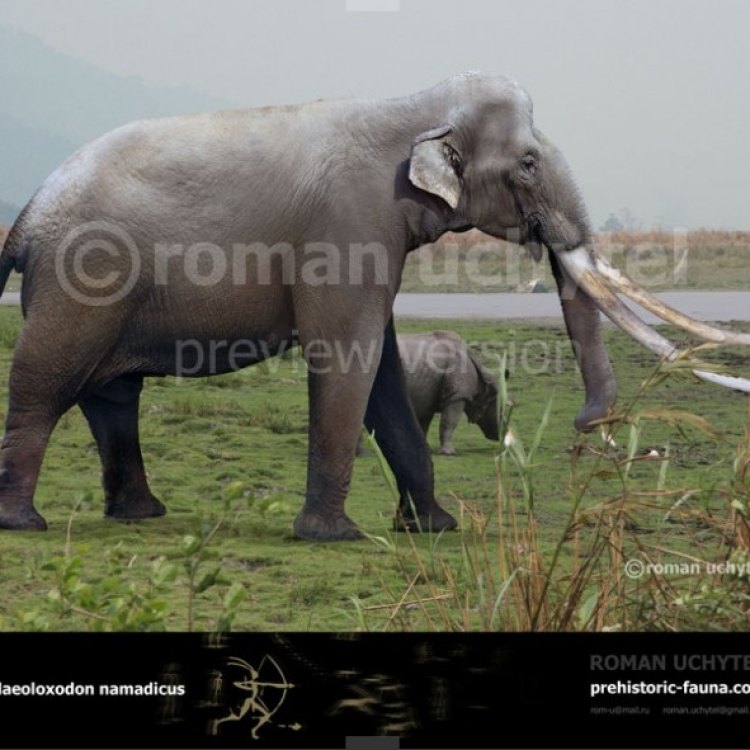
The Giant of Ancient Asia: Palaeoloxodon Namadicus and Its Epic Journey
Disclaimer: The content provided is for informational purposes only. We cannot guarantee the accuracy of the information on this page 100%. All information provided here may change without prior notice.

